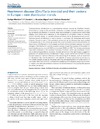Identificador persistente para citar o vincular este elemento:
https://accedacris.ulpgc.es/jspui/handle/10553/45360
| Campo DC | Valor | idioma |
|---|---|---|
| dc.contributor.author | Morchon Garcia,Rodrigo | en_US |
| dc.contributor.author | Carretón Gomez, Elena | en_US |
| dc.contributor.author | González-Miguel, J. | en_US |
| dc.contributor.author | Mellado-Hernández, I. | en_US |
| dc.date.accessioned | 2018-11-22T09:14:04Z | - |
| dc.date.available | 2018-11-22T09:14:04Z | - |
| dc.date.issued | 2012 | en_US |
| dc.identifier.issn | 1664-042X | en_US |
| dc.identifier.other | WoS | - |
| dc.identifier.uri | https://accedacris.ulpgc.es/handle/10553/45360 | - |
| dc.description.abstract | Cardiopulmonary dirofilariasis is a cosmopolitan disease caused by Dirofilaria immitis, which affects mainly canids and felids. Moreover, it causes zoonotic infections, producing pulmonary dirofilariasis in humans. Heartworm disease is a vector-borne transmitted disease, thus transmission depends on the presence of competent mosquito species, which is directly related to favorable climate conditions for its development and survival. Cardiopulmonary dirofilariasis is mainly located in countries with temperate and tropical climates. Europe is one of the continents where animal dirofilariasis has been studied more extensively. In this article we review the current prevalence of canine and feline cardiopulmonary dirofilariasis in the European continent, the transmission vectors, the current changes in the distribution and the possible causes, though the analysis of the epidemiological studies carried out until 2001 and between 2002 and 2011. The highest prevalences have been observed in the southern European countries, which are considered historically endemic/hyperendemic countries. Studies carried out in the last 10 years suggest an expansion of cardiopulmonary dirofilariasis in dogs toward central and northern Europe. Several factors can exert an influence on the spreading of the disease, such as movement of infected animals, the introduction of new species of mosquitoes able to act as vectors, the climate change caused by the global warming, and development of human activity in new areas. Veterinary controls to prevent the spreading of this disease, programs of control of vectors, and adequate protocols of prevention of dirofilariasis in the susceptible species should be carried out. | en_US |
| dc.language | eng | en_US |
| dc.relation.ispartof | Frontiers in Physiology | en_US |
| dc.source | Frontiers in Physiology, v. 3 JUN (Article 196) | en_US |
| dc.subject | 310907 Patología | en_US |
| dc.subject | 240112 Parasitología animal | en_US |
| dc.subject.other | Heartworm disease | en_US |
| dc.subject.other | Dirofilaria immitis | en_US |
| dc.subject.other | Dogs | en_US |
| dc.subject.other | Cats | en_US |
| dc.subject.other | Prevalence | en_US |
| dc.subject.other | Vectors | en_US |
| dc.subject.other | Europe | en_US |
| dc.title | Heartworm disease (dirofilaria immitis) and their vectors in Europe - new distribution trends | en_US |
| dc.type | info:eu-repo/semantics/review | en_US |
| dc.type | Article | en_US |
| dc.identifier.doi | 10.3389/fphys.2012.00196 | - |
| dc.identifier.scopus | 84866417445 | - |
| dc.identifier.isi | 000209173000193 | - |
| dc.contributor.authorscopusid | 6507293463 | - |
| dc.contributor.authorscopusid | 36143929200 | - |
| dc.contributor.authorscopusid | 27667647000 | - |
| dc.contributor.authorscopusid | 55360595900 | - |
| dc.identifier.issue | Article 196 | - |
| dc.relation.volume | 3 JUN | en_US |
| dc.investigacion | Ciencias de la Salud | en_US |
| dc.type2 | Reseña | en_US |
| dc.contributor.daisngid | 598197 | - |
| dc.contributor.daisngid | 1038823 | - |
| dc.contributor.daisngid | 1423430 | - |
| dc.contributor.daisngid | 34634416 | - |
| dc.description.numberofpages | 11 | en_US |
| dc.utils.revision | Sí | en_US |
| dc.contributor.wosstandard | WOS:Morchon, R | - |
| dc.contributor.wosstandard | WOS:Carreton, E | - |
| dc.contributor.wosstandard | WOS:Gonzalez-Miguel, J | - |
| dc.contributor.wosstandard | WOS:Mellado-Hernandez, I | - |
| dc.date.coverdate | Septiembre 2012 | en_US |
| dc.identifier.ulpgc | Sí | es |
| dc.description.sjr | 0,822 | |
| dc.description.sjrq | Q2 | |
| dc.description.scie | SCIE | |
| item.fulltext | Con texto completo | - |
| item.grantfulltext | open | - |
| crisitem.author.dept | GIR IUIBS: Medicina Veterinaria e Investigación Terapéutica | - |
| crisitem.author.dept | IU de Investigaciones Biomédicas y Sanitarias | - |
| crisitem.author.dept | GIR IUIBS: Medicina Veterinaria e Investigación Terapéutica | - |
| crisitem.author.dept | IU de Investigaciones Biomédicas y Sanitarias | - |
| crisitem.author.dept | Departamento de Patología Animal, Producción Animal, Bromatología y Tecnología de Los Alimentos | - |
| crisitem.author.orcid | 0000-0003-2699-1482 | - |
| crisitem.author.orcid | 0000-0001-6509-910X | - |
| crisitem.author.parentorg | IU de Investigaciones Biomédicas y Sanitarias | - |
| crisitem.author.parentorg | IU de Investigaciones Biomédicas y Sanitarias | - |
| crisitem.author.fullName | Morchon García, Rodrigo | - |
| crisitem.author.fullName | Carretón Gómez, Elena | - |
| Colección: | Reseña | |
Citas SCOPUSTM
189
actualizado el 08-jun-2025
Citas de WEB OF SCIENCETM
Citations
172
actualizado el 08-jun-2025
Visitas
90
actualizado el 16-sep-2023
Descargas
96
actualizado el 16-sep-2023
Google ScholarTM
Verifica
Altmetric
Comparte
Exporta metadatos
Los elementos en ULPGC accedaCRIS están protegidos por derechos de autor con todos los derechos reservados, a menos que se indique lo contrario.
